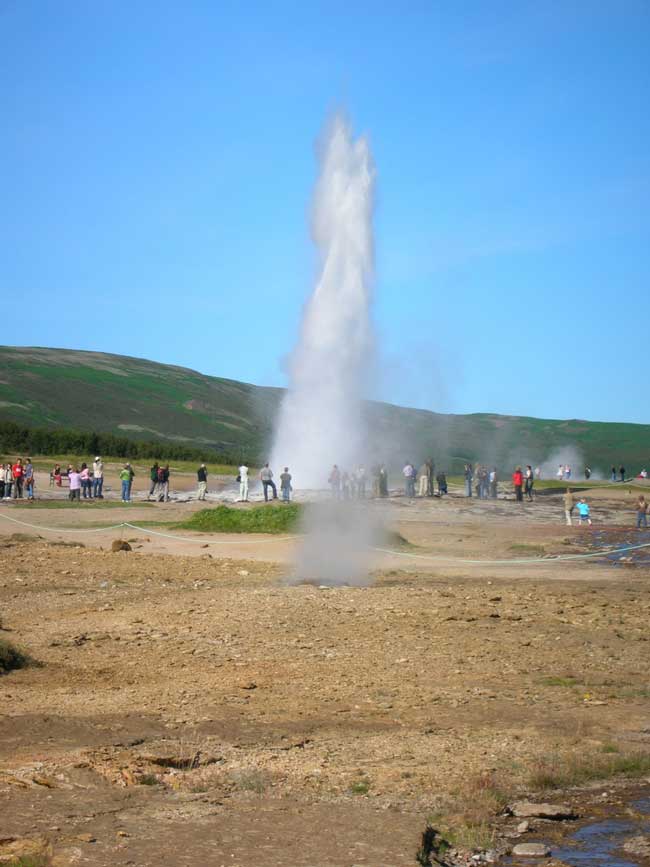Whatever Happened to Geothermal Energy?

Editor's Note: This article is part of an occasional LiveScience series about ideas to ease humanity's impact on the environment.
The world's greatest source of power lies a few miles under our feet. Geothermal energy, which draws on the heat from the Earth's interior, could supply the current global energy demand for more than 30,000 years.
The trick is tapping into it. Geothermal energy accounts for less than a half-percent of global energy consumption, according to the International Energy Association.
Most of the active geothermal plants are located in volcanically active places, like Iceland, where the Earth's outer crust is thin.
"Conventional geothermal has limited use because the required geology is not found everywhere," said geophysicist Roy Baria of the company Mil-Tech UK LTD.
Baria and others are engineering non-conventional places where the heat is farther down and there is no room for water to flow. These geological enhancements can have their drawbacks: One project in Switzerland was shut down earlier this year due to induced earthquakes.
Hot-button issue
Sign up for the Live Science daily newsletter now
Get the world’s most fascinating discoveries delivered straight to your inbox.
A typical geothermal plant captures steam escaping from underground and uses it to turn turbine blades that generate electricity. The first such power plant began in Italy in 1904 and continues to work to this day.
Considered a green technology, geothermal does raise environmental concerns. In certain cases, steam extraction can allow other gases, like carbon dioxide (CO2), to escape. However, the amount of CO2 released per kilowatt-hour of electricity is only a few percent that of coal-fired power plants.
Although it supplies power more consistently than the fickle wind and daily setting sun, geothermal energy is not entirely renewable. The largest geothermal development in the world, the Geysers in California, actually began to decline because it essentially ran out of steam.
"It was overproduced," said Robert Zierenberg a geologist at the University of California, Davis.
The Geysers has stabilized, thanks to the underground injections of imported wastewater. With the fear or depleting natural resources, environmentalists have fought the development of other geothermal projects in places like Hawaii and Yellowstone.
From the land of ice and snow
But up in Iceland, geothermal is warmly accepted.
"Iceland is an ideal case for geothermal because it is a volcanic island with no natural fossil fuel reserves," said Peter Schiffman, also from U.C. Davis. Geothermal plants supply approximately a quarter of Iceland's electric power, and leftover heat is used to warm homes and greenhouses.
"The Icelanders have taken as much as they can from their geothermal resource," Zierenberg told LiveScience.
But they would like to take even more. Zierenberg and Schiffman are part of the Iceland Deep Drilling Project (IDDP), which hopes to increase the normal 5 megawatt power output of a geothermal plant by a factor of 10. This will require digging into the hottest rock ever utilized.
Typical geothermal power plants tap into steam from underground fissures where the temperature is roughly 400 degrees Fahrenheit (200 degrees Celsius).
By drilling 3 miles down in a selected spot, IDDP will reach temperatures of 840 degrees Fahrenheit (450 degrees Celsius). At this temperature and pressure, water is in a strange liquid-gas phase called supercritical, which carries 10 times more energy than steam, Schiffman said.
The challenge will be divining where this supercritical water is. Fluid can only flow in rocks that are fractured, so IDDP has chosen a site where seismic activity is high.
"We look near earthquake areas because that is where cracking is occurring," Zierenberg said.
Enhancing nature
In other parts of the world, like Australia, Japan and Nevada, geo-engineers are generating their own tiny earthquakes to make hot dry rock amenable to geothermal energy.
"The way ahead is engineered, or enhanced, geothermal systems," Baria said. Often referred to as EGS, these projects require drilling a well a few miles down and pumping water in at high pressure. This induces small seismic events that fracture the rock and provide a route for water to flow. A second well is then drilled to bring the boiled water to the surface.
During the fracturing process, the typical size of the seismic events would not even register on the Richter scale, according to Baria.
"Normally it's peanuts," he said. "You notice it as a nuisance, but it's no threat to structures."
However, high-pressure water pumping at a Swiss EGS site last December induced four earthquakes in Basel ranging from 3.1 to 3.4 on the Richter scale.
"That project should not have been started there," Baria said, because Basel has a history of earthquakes including one that destroyed the city in 1356. "We advised that it was not a good place."
Local authorities in Basel have postponed the project while a review is being performed.
Land of opportunity
In a properly chosen location, earthquakes should not be a concern, Baria said. The best rock to drill into is igneous, which can be found beneath 70 percent of the Earth's land surface. In fact, a recent MIT report found that the U.S. potential for EGS is 50 times that of the country's other potential energy sources combined.
The biggest hurdle is the cost of drilling, which will generally need to be at least 3 miles down. Baria expects the average EGS power plant to cost $20 million to $30 million and to last 20 to 25 years.
Zierenberg doubted that the United States is ready for that kind of large-scale development.
"It's different in Iceland. They're more willing to embrace geothermal energy because they can see their glaciers melting," Zierenberg said.
Ancient 'military outpost' in North Macedonia might be birthplace of Alexander the Great's grandmother
NASA rover discovers out-of-place 'Skull' on Mars, and scientists are baffled
A long-lost ice sheet could predict the future of New York City — one in which Lower Manhattan and Coney Island are 'perpetually submerged'










